History of coins in Italy
Italy has a long history of different coinage types, which spans thousands of years. Italy has been influential at a coinage point of view: the medieval Florentine florin, one of the most used coinage types in European history and one of the most important coins in Western history,[1] was struck in Florence in the 13th century, while the Venetian sequin, minted from 1284 to 1797, was the most prestigious gold coin in circulation in the commercial centers of the Mediterranean Sea.[2]
| History of Italy |
|---|
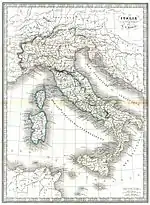 |
|
|
| Part of a series on |
| Numismatics the study of currency |
|---|
 |
Despite the fact that the first Italian coinage systems were used in the Magna Graecia and Etruscan civilization, the Romans introduced a widespread currency throughout Italy. Unlike most modern coins, Roman coins had intrinsic value.[3] The early modern Italian coins were very similar in style to French francs, especially in decimals, since it was ruled by the country in the Napoleonic Kingdom of Italy. They corresponded to a value of 0.29 grams of gold or 4.5 grams of silver.[4]
Since Italy has been for centuries divided into many historic states, they all had different coinage systems, but when the country became unified in 1861, the Italian lira came into place, and was used until 2002.[5] The term originates from libra, the largest unit of the Carolingian monetary system used in Western Europe and elsewhere from the 8th to the 20th century.[6] In 1999, the euro became Italy's unit of account and the lira became a national subunit of the euro at a rate of 1 euro = 1,936.27 lire, before being replaced as cash in 2002.
Antiquity
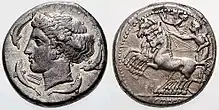
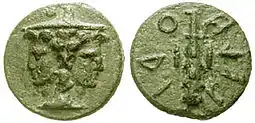
Despite the fact that the first Italian coinage systems were used in the Magna Graecia and Etruscan civilization, the Romans introduced a widespread currency throughout Italy. Unlike most modern coins, Roman coins had intrinsic value.[3]
Greek coinage of Italy and Sicily originated from local Italiotes and Siceliotes who formed numerous city-states in Magna Graecia. These Hellenistic communities descended from Greek migrants. Southern Italy was so thoroughly hellenized that it was known as the Magna Graecia. Each of the polities struck their own coinage. Taras (now called Taranto) was among the most active of all Magna Graecia, which minted mainly in silver but often also in gold.[7] By the second century BC some of these Greek coinages evolved under Roman rule, and can be classified as the first Roman provincial currencies.
The brief period of Etruscan coinage, with the predominance of marks of value, seems to be an amalgam that reconciles two very different monetary systems: the 'primitive' bronze-weighing and aes grave economy[8] of central Italy with that of struck silver and gold issues of southern Italian Greek type not familiar in Etruria.

The family of Social War coinage includes all the coins issued by the Italic allies of the Marsic confederation, Marsi, Peligni, Piceni, Vestini, Samnites, Frentani, Marrucini, and Lucani, during the Social War (91–88 BC) against Rome. Inspired by the Roman denarius,[9] their circulation (and perhaps their release) continued even after the conflict ended, contemporary and promiscuously with their republican models.
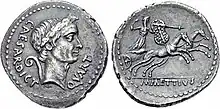
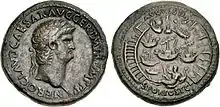
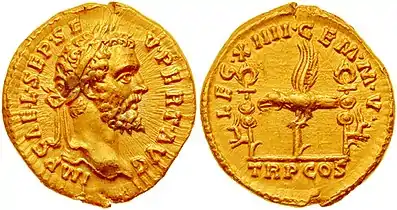
Roman currency for most of Roman history consisted of gold, silver, bronze, orichalcum and copper coinage.[10] From its introduction during the Republic, in the third century BC, through Imperial times, Roman currency saw many changes in form, denomination, and composition. A persistent feature was the inflationary debasement and replacement of coins over the centuries. Notable examples of this followed the reforms of Diocletian. This trend continued with Byzantine currency.
After the fall of the Western Roman Empire, the solidus continued to circulate for some time among the Franks; his name was kept and transformed into "sol" in French, then "sou". The peoples settled in the Empire, Burgundians, Ostrogoths and Visigoths, also issued coins imitating the Roman system, including the solidus.[11] Roman currency names survive today in many countries via the Carolingian monetary system, such as the Arabic dinar (from the denarius coin), the British pound, the peso (both translations of the Roman libra, a unit of weight), and Portuguese dinheiro (from the denarius coin).
The manufacture of coins in the Roman culture, dating from about the 4th century BC, significantly influenced later development of coin minting in Europe. The origin of the word "mint" is ascribed to the manufacture of silver coin at Rome in 269 BC near the temple of Juno Moneta.[12] This goddess became the personification of money, and her name was applied both to money and to its place of manufacture. Roman mints were spread widely across the Empire, and were sometimes used for propaganda purposes. The populace often learned of a new Roman Emperor when coins appeared with the new emperor's portrait.
While they contained precious metals, the value of a coin was higher than its precious metal content, so they were not bullion. Estimates of their value range from 1.6 to 2.85 times their metal content, thought to equal the purchasing power of 10 modern British Pound Sterling (US$15) at the beginning of the Roman Empire to around 18 Pound Sterling (US$29) by its end (comparing bread, wine and meat prices) and, over the same period, around one to three days' pay for a Legionnaire.[13]
Middle Ages and Renaissance
Italy has been influential at a coinage point of view: the medieval Florentine florin, one of the most used coinage types in European history and one of the most important coins in Western history,[1] was struck in Florence in the 13th century, while the Venetian sequin, minted from 1284 to 1797, was the most prestigious gold coin in circulation in the commercial centers of the Mediterranean Sea.[2]
Florentine florin
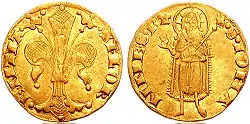
The Florentine florin was struck from 1252 to 1523 with no significant change in its design or metal content standard.[14] It had 54 grains (3.499 grams, 0.113 troy ounce) of nominally pure or 'fine' gold[15] with a purchasing power difficult to estimate (and variable) but ranging according to social grouping and perspective from approximately 140 to 1,000 modern US dollars. The name of the coin comes from the Giglio bottonato (it), the floral emblem of the city, which is represented at the head of the coin.[16]
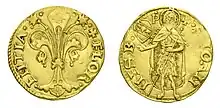
The fiorino d'oro (gold florin) was used in the Republic of Florence and was the first European gold coin struck in sufficient quantities since the 7th century to play a significant commercial role. The florin was recognised across large parts of Europe. The territorial usage of the lira and the florin often overlapped, where the lira was used for smaller transactions (wages, food purchases), the florin was for larger transactions such as those used in dowries, international trade or for tax-related matters.[17]
The Florentine florin is of the most used coinage types in European history and one of the most important coins in Western history.[1] The first minting of the florin occurred in 1252, at the time the value of the florin was equal to the lira, but by 1500 the florin had appreciated, seven lire amounted to one florin.[17] The design of the original Florentine florins was the distinctive fleur-de-lis badge of the city on one side and on the other a standing and facing figure of St. John the Baptist[18] wearing a cilice. The Dutch guilder is symbolized as Fl. or ƒ, which means florijn (florin). The Hungarian forint is named after the florin.[19]
Venetian sequin
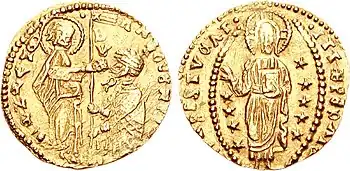
The sequin (Venetian and Italian: zecchino [dzekˈkiːno]) is a gold coin minted by the Republic of Venice from the 13th century onwards. The design of the Venetian sequin remained unchanged for over 500 years, from its introduction in 1284 to the fall of the Republic of Venice in 1797, making it the most prestigious gold coin in circulation in the commercial centers of the Mediterranean Sea.[2] No other coin design has ever been produced over such a long historical period.
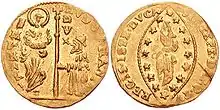
The reverse bears a motto in Latin hexameter: Sit tibi, Christe, datus // quem tū regis, iste ducātus ("Christ, let this duchy that you rule be given to you").[20] On the obverse there is Mark the Evangelist, patron saint of Venice, who is depicted with a beard and halo, is facing to the right and is wrapped in a large cloak while holding the Gospel with his left hand. With his right hand the saint offers a banner to the Doge of Venice who is kneeling to the left and holding the staff with both hands. The Doge wears a rich fur-trimmed cloak and the ducal cap, under the flag facing to the right the vertical writing "dux", around it "s·m·venet" and the name of the Doge.[20]
The quality of the minting is superior to all contemporary coins and this shows that the artists of the Venice Mint had already reached a high level of taste and refinement of design at the time.[21] Initially called "ducat" (ducato), for the ruling Doge of Venice who was prominently depicted on it, it was called the zecchino, after the Zecca (mint) of Venice, since 1543 when Venice began minting a silver coin also called a ducat.
Genoese lira
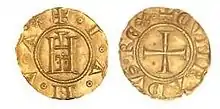
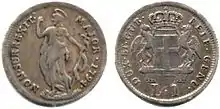
The Genoese lira (Italian: Lira genovese) was the currency of the Republic of Genoa until 1797. The mint in the Republic of Genoa began its production around 1138,[22] with coins introduced in line with similar versions issued in the rest of Europe, as follows:
- The silver denaro in 1138, containing 1.06 grams of 1⁄3 fine silver (or 84.8 g fine silver in a lira);
- The silver grosso in 1172 worth 4 denari, of 1.4 g of 23⁄24 fine silver (or 80.5 g fine silver in a lira);
- The gold Genovino d'oro in 1252, at about the same time as the Florentine florin; of 3.5 g fine gold, and worth 1⁄2 lira (each lira worth either 7 g fine gold or 70 g fine silver);
- The testone or 1-lira coin before 1500, containing about 13 g of 23⁄24 fine silver (or 12.5g fine). It was the highest-valued Italian coin unit in the end of the 15th century.[23]
Genoese currency became important in the 16th century during the Golden age of Genoese banking, with the Spanish Empire funnelling its massive wealth from Spanish America through the Bank of Saint George. With the decline in the fortunes of the Genoese banks and the Spanish Empire in the 17th century, however, the Genoese lira also depreciated substantially. The silver scudo's value increased to 6.5 lire in 1646, 7.4 lire in 1671, and 8.74 lire just before the Austrian occupation of Genoa in 1746.[24]
Papal States florin

The Byzantine monetary system is followed in the papal coinage until the reign of Pope Leo III, after which the system of the Frankish Empire obtains.[25] Pope John XXII adopted the Florentine system, and coined gold forms, but the weight of this coin varied from 22 to 30 carats (4.4 to 6 g), until Pope Gregory XI reduced it to the original 24 carats (4.8 g); but deterioration came again, and then there were two kinds of florins, the papal florin, which maintained the old weight, and the florin di Camera, the two being in the ratio of 69 papal florins = 100 florins di Camera = 1 gold pound = 10 carlini.[25] The ducat was coined in the papal mint from the year 1432; it was a coin of Venetian origin that circulated with the florin, which in 1531 was succeeded by the scudo, a piece of French origin (écu) that remained the monetary unit of the Pontifical States.[25]
Anconetan agontano
.jpg.webp)
The agontano was the currency used by the Italian Maritime Republic of Ancona from the 12th to the 16th centuries during its golden age. It was a large silver coin of 18-22mm in diameter and a weight of 2.04-2.42 grams, of roughly equivalent value to the Milanese Soldo. The first reports of Ancona's medieval coinage begin in the 12th century when the independence of the city grew and it began to mint coinage without Imperial or papal oversight.[26]
The coin, also called "Grosso Agontano", was a great success and its type was imitated in other cities of Marche and also in Emilia-Romagna, Tuscany, Lazio and Abruzzo. For example, coins of Massa Marittima,[27] Ravenna, Rimini, Volterra,[28] Pesaro and Ferrara.[29] show a marked influence from Ancona.
Milanese soldo
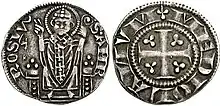
The soldo was an Italian medieval silver coin, issued for the first time in the late 12th century at Milan by Emperor Henry VI.[30] The name derives from the late Roman coin solidus.[31]
It quickly became widespread in Italy, where it was coined in Genoa, Bologna, and numerous other cities. In Venice, the soldo was minted from the reign of Francesco Dandolo onward, remaining in use also after the republic's dissolution in 1797 and during the Austrian occupation, until 1862. In the 14th century Florence, a soldo equaled 1⁄20 of a lira and 12 denari.[32]
Neapolitan gigliato
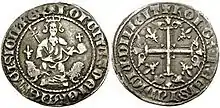
The gigliato, also gillat or carlino, was a coin of pure silver established in 1303 by Charles II of Anjou in Naples, and then also in Provence from 1330. Its name derives from the Lilies ("giglio") depicted on the reverse entwined around a cross. The coin weighed 4 grams. This type of coin was widely copied in the Eastern Mediterranean, especially by the Turks, such as the Emir of Saruhan.[33][34]
Charles II of Anjou's silver gigliato was the same diameter as the dominant silver coin of its time, the French gros tournois, or as the grosso rinforzato being struck by the Roman Senate, i.e. 24 m.m.. It contained 4.01 grams of .929 fine silver, or 3.73 grams of pure silver. Its types were more typical of French gold coins, especially Philip the Fair's petit royal d’or, than Italian silver coins.[35]
Bolognese bolognino
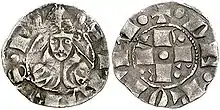
The Bolognino was a coin minted in Bologna and other cities of medieval Italy from the late 12th century to the 17th century.
The coin originated in 1191, when emperor Henry VI granted Bologna the right to mint a silver denaro. In 1236 this unit was rechristened Bolognino piccolo (Small Bolognino) when the Bolognino grosso (Big Bolognino) was introduced, with the value of a 12 soldi. It weighed 9 carats.[36]
The grosso was adopted in other Italian communes and cities, such as Ravenna and Rimini and copied by other mints, such as those of Lucca, Rome and other cities in Abruzzo and Marche. The value changed depending from the current political and economic situation.
The bolognino was no longer struck starting from the 18th century. Multiples up to 100 bolognini continued to exist, however.
A golden bolognino, introduced in 1380, had the value of 30 silver bolognini (same title and weight of the Papal ducato.
Sicilian augustalis
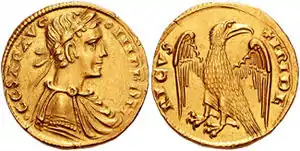
An augustalis or augustale, also agostaro, was a gold coin minted in the Kingdom of Sicily beginning in 1231.[37] It was issued by Frederick II, Holy Roman Emperor (from 1220) and King of Sicily (from 1198), and was minted until his death in 1250.[38][39] In addition, a half augustalis was issued. It was identical in design, but smaller and half the weight.[40] The name augustalis means literally "of the august one", referring to the coin's provenance from the emperor himself, but also linking it with the Roman Emperor, who was commonly styled Augustus.
The augustalis bore a Latin inscription and was widely circulated in Italy. It was patterned after the Roman aureus.[41] It was struck at Brindisi and Messina with accompanying billon deniers.[41] The style of the augustalis has been described as splendid and proto-Renaissance; the quality of its execution and its fineness was high.[41] The augustalis had a nominal weight of 5.31 grams and was 201⁄2 carats (854/1000) fine.[40] The legal value was a quarter of a Sicilian gold ounce.[40]
Modern era
The early modern Italian coins were very similar in style to French francs, especially in decimals, since it was ruled by the country in the Napoleonic Kingdom of Italy. They corresponded to a value of 0.29 grams of gold or 4.5 grams of silver.[4]
Papal States scudo

The Papal States scudo (plural: scudi) was the coinage system used in the Papal States until 1866. It was subdivided into 100 baiocchi (singular: baiocco), each of 5 quattrini (singular: quattrino). Other denominations included the grosso of 5 baiocchi, the carlino of 7+1⁄2 baiocchi, the giulio and paoli both of 10 baiocchi, the testone of 30 baiocchi and the doppia of 3 scudi.
Between 1798 and 1799, the revolutionary French forces established the Roman Republic, which issued coins denominated in baiocco and scudo. In addition, the states of Ancona, Civitavecchia, Clitunno, Foligno, Gubbio, Pergola and Perugia changed their coinage system to that of the Roman Republic. The popes entrusted the production of the coining to the best artists of the time.[42]
In 1808, the Papal States were annexed by France, and French francs circulated as the official coins. When the Pope's authority was restored in 1814, the scudo was restored as the currency. However, the coinage of the individual states was not resumed. In 1849, another Roman Republic was established which issued coins centrally and in Ancona.
In 1866, the scudo was replaced by the lira, equivalent to the Italian lira. The exchange rate used was 5.375 lire = 1 scudo.[43]
Sicilian oncia

The oncia (plural oncie or once) or onza (pl. onze) was a gold coin minted between 1732 and 1860 in the Kingdom of Sicily. One oncia was equivalent to 30 tarì, 600 grani and 3600 denari (pennies). It was also later minted in the Kingdom of Naples, and a silver coin of the same value was minted by the Knights of Malta. The name is derived from the ancient Roman uncia. It may sometimes be translated "ounce". Conventionally, a sum of money is indicated by numbers of oncie, tarì, grani and denari separated by full stops, thus 2.2.15.1 indicates 2 oncie, two tarì, 15 grani and 1 denaro. The lesser denominations were minted, as was the ducat (six of which equalled an oncia) and the carlino (60 to the oncia).[44][45]
Parman lira
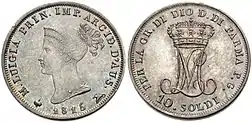
The Parman lira was Parma's official currency before 1802, and later revived from 1815 to 1859. The Duchy of Parma had its own coinage system until it was made a part of France in 1802. This lira was subdivided into 20 soldi (singular: soldo), each of 12 denari (singular: denaro), with the sesino worth 6 denari and the ducato was worth 7 lire. The currency was replaced by the French franc.
After the re-establishment of Parman independence, the Parman currency system was introduced in 1815.[46] Also called the lira, it was subdivided into 20 soldi or 100 centesimi. However, this lira was equal to the French franc and the Sardinian lira, and it circulated alongside the latter. It weighed 5 grams, and had a purity of 9/10 of silver. Since 1861, Parma has used the equivalent Italian lira.
Sardinian scudo
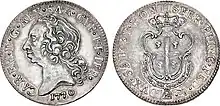
The Sardinian scudo (plural: scudi) was the currency of the Kingdom of Sardinia from 1720 to 1816. It was subdivided into 2½ lire (singular: lira), each of 4 reales, 20 soldi, 120 cagliarese or 240 denari. The doppietta was worth 2 scudi. It was replaced by the Sardinian lira.
In the late 18th century, coins circulated in denominations of 1 and 3 cagliarese, 1 soldo, ½ and 1 reale, ¼, ½ and 1 scudo, 1, 2½ and 5 doppietta. The cagliarese denominations were struck in copper, the soldo and reale in billon, the scudo in silver and the doppietta in gold.[47]
Luccan lira

The Luccan lira (plural: lire) was the currency of the Republic of Lucca until 1800 and again of the Duchy of Lucca between 1826 and 1847. It was subdivided into 20 soldi, each of 3 quattrini or 12 denari. The lira circulated until 1800, when the French franc was introduced, accompanied by the Luccan franc from 1805. After Napoleon's fall, the Luccan State remained without an official currency, using both old francs and Tuscan lira and Tuscan fiorino. The Luccan lira reappeared in 1826 by order of Duke Charles Louis, replacing all circulating currencies.[48]
The Luccan lira contained less silver than the Tuscan lira had. Lucca was absorbed by Tuscany in 1847 and the Luccan lira was replaced by the Tuscan fiorino at a rate of 1 fiorino = 1+2⁄3 Tuscan lire = 2 Luccan lire. In 1826, coins were introduced in denominations of q.1, q.2 and q.5, 1, 2, 3, 5 and 10 soldi, and 1 and 2 lire. The quattrini denominations and the s.1 were struck in copper, with the higher denominations in silver.
Neapolitan piastra
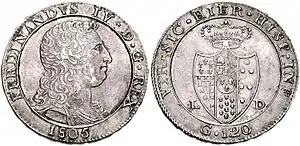
The Neapolitan piastra was the most common silver coin of the Kingdom of Naples. In order to distinguish it from the piastra issued on the island of Sicily, it is referred to as the "Neapolitan piastra" as opposed to the "Sicilian piastra". These two piastra were equal but were subdivided differently. The Neapolitan piastra was divided into 120 grana (singular: grano), each of 2 tornesi (singular: tornese) or 12 cavalli (singular: cavallo). There were also the carlino worth 10 grana and the ducato worth 100 grana.[49]
In 1812, the Neapolitan lira was introduced by the occupying French in an attempt to decimalize the Neapolitan currency units. However, the attempt failed, and the decimalization was limited to changing the value of the cavallo to one tenth of a grano. After the restoration of Bourbon control, a single currency was issued for the whole of the Two Sicilies, the Two Sicilies piastra. This new piastra was subdivided in the same way as the Neapolitan piastra.
Two Sicilies piastra
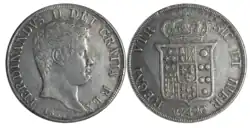
The Two Sicilies piastra was the coinage system or currency of the Kingdom of the Two Sicilies between 1815 and 1860. It was subdivided into 120 grana (singular: grano), each of 2 tornesi (singular: tornese). Accounts were kept in ducato, worth 100 grana.[50] The subdivision and the coinage of the currency were simplified with respect to the pre-Napoleonic era: only three denominations survived. The ducat proper was the name of the gold coins, and curiously it did not exist as a single unit; the grana (singular: grano) was the name of the silver coins, itself also not existing as a single unit; the tornesel (Italian: tornese) was the name of the copper coins, which were worth half a grana. Accounts were kept in ducats, each of 100 grana or 200 tornesels.[51]
The piastra was the unofficial name of the biggest silver coin, which had a value of 120 grana. When the Italian lira replaced the coinage of the House of Bourbon in 1861, a rate of 1 piastra = 5.1 lire was established.
Sardinian lira

The Sardinian lira was the currency of the Kingdom of Sardinia between August 6, 1816, and March 17, 1861. It was subdivided into 100 centesimi (singular centesimo) and was equal in value to the French franc (4.5 grams of silver), which had previously been used as the currency of the Kingdom of Sardinia, having replaced the Piedmontese scudo by 1801.
Since the Sardinian lira was little more than another version of the French franc, it could circulate also in France, and the French coins could circulate in Piedmont (the mainland part of the Kingdom of Sardinia). The Sardinian lira was replaced at par by the Italian lira in 1861, as a consequence of the process of Italian unification.[52] Similar to the majority of 19th century currencies, the Sardinian lira was not affected by significant episodes of inflation during all its existence.
On each coin, the ruling monarch was styled in Latin as King of Sardinia, Cyprus and Jerusalem by the Grace of God on the front side, and Duke of Savoy, Genoa and Montferrat, Prince of Piedmont et cetera on the back side.
Tuscan florin
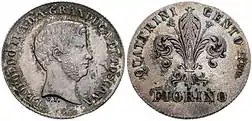
The Tuscan florin was the currency of Tuscany between 1826 and 1859. It was subdivided into 100 quattrini (singular: quattrino), with an additional denomination called the paolo, worth 40 quattrini, in circulation.
During the Napoleonic Wars, Tuscany was annexed by France and the French franc was introduced, together with its satellite Italian lira. The previous lira did not disappear, creating a big confusion between the old Tuscan lira and the new Italian lira. So, when Duke Leopold II rose to power in 1824, he decided to introduce a new basic currency. The Tuscan florin replaced the Tuscan lira at a rate of 1+2⁄3 lire = 1 Tuscan florin.[53]
In 1847, Tuscany absorbed Lucca and the Tuscan florin replaced the Luccan lira at a rate of 1 Tuscan florin = 2 lire. After a brief revolutionary coinage, the Tuscan florin was replaced in 1859 by a provisional currency denominated in "Italian lira", equal to the Sardinian lira, with 1 Tuscan florin = 1.4 Italian lire.
Lombardy-Venetia florin
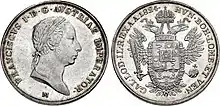
The Lombardy-Venetia florin was the currency of Lombardy-Venetia (reduced to the sole Venetia three years before) between 1862 and 1866. It replaced the Lombardo-Venetian lira at a rate of 1 florin = 3 lire.[54] The florin was equivalent to the Austro-Hungarian florin. Although it was subdivided into 100 soldi rather than 100 kreutzers, Austrian coins circulated in Venetia.
The only coins issued specifically for Venetia were copper 1⁄2 and 1 soldo pieces. The name soldo was chosen due to the equivalence of the predecimal kreutzer and soldo, both worth 1⁄120 of a Conventionsthaler.
The florin was replaced by the Italian lira at the rate of 1 lira = 40+1⁄2 soldi (1 florin = 2.469 lire). This rate corresponded to the comparative silver contents of the lira and florin coins.
Contemporary period
Since Italy has been for centuries divided into many historic states, they all had different coinage systems, but when the country became unified in 1861, the Italian lira came into place, and was used until 2002. In 1999, the euro became Italy's unit of account and the lira became a national subunit of the euro at a rate of 1 euro = 1,936.27 lire, before being replaced as cash in 2002.
Italian lira
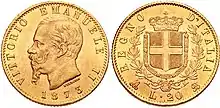
The Italian lira (Plural: lire) was the currency of Italy between 1861 and 2002. It was introduced by the Napoleonic Kingdom of Italy in 1807 at par with the French franc, and was subsequently adopted by the different states that would eventually form the Kingdom of Italy in 1861. It was subdivided into 100 centesimi (singular: centesimo), which means "hundredths" or "cents". The lira was also the currency of the Albanian Kingdom from 1941 to 1943.[55]
The term originates from libra, the largest unit of the Carolingian monetary system used in Western Europe and elsewhere from the 8th to the 20th century.[6] The Carolingian system is the origin of the French livre tournois (predecessor of the franc), the Italian lira, and the pound unit of sterling and related currencies.
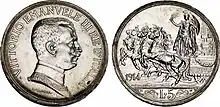

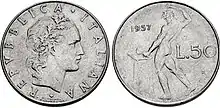
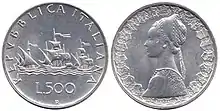
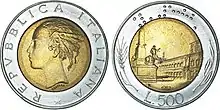
There was no standard sign or abbreviation for the Italian lira. The abbreviations Lit. (standing for Lira italiana) and L. (standing for Lira) and the signs ₤ or £ were all accepted representations of the currency. Banks and financial institutions, including the Bank of Italy,[56] often used Lit.[57][58] and this was regarded internationally as the abbreviation for the Italian lira.[59] Handwritten documents and signs at market stalls would often use "£" or "₤",[60][61] while coins used "L."[62][63] Italian postage stamps mostly used the word lire in full but some (such as the 1975 monuments series) used "L." The name of the currency could also be written in full as a prefix or a suffix (e.g. Lire 100,000 or 100,000 lire). The ISO 4217 currency code for the lira was ITL.
Italian unification also highlighted the confusion of the pre-unification Italian monetary system which was mostly based on silver monometallism and therefore in contrast with the gold monometallism in force in the Kingdom of Sardinia and in the major European nations.[64] To reconcile the various monetary systems it was decided to opt for bimetallism, taking inspiration from the French franc model, from which the dimensions of the coins and the exchange rate of 1 to 15.50 between gold and silver were taken. The Italian monetary system, however, differed from the French one in two aspects: silver coins could be exchanged in unlimited quantities with the State, but limited quantities between private individuals and it was decided to mint coins that nominally had 900‰ fine silver, but which in fact they contained 835‰ so as to approach the real exchange rate between gold and silver which was approximately 1 to 14.38.[65] Exactly four months after the proclamation of the Kingdom of Italy, the government introduced the new national currency, the Italian lira. The legal tender of the new currency was established by the Royal Decree of 17 July 1861 which specified the exchange of pre-unification coins into lire and the fact that local coins continued to be legal tender in their respective provinces of origin.[66]
On 24 August 1862 the decree was issued which established the decommissioning of all other coins circulating in the various pre-unification states by the end of the year.[67] Italian lira was a direct continuation of the Sardinian lira. Other currencies replaced by the Italian lira included the Lombardo-Venetian lira, the Two Sicilies piastra, the Tuscan fiorino, the Papal States scudo and the Parman lira. In 1865, Italy formed part of the Latin Monetary Union in which the lira was set as equal to, among others, the French, Belgian and Swiss francs: in fact, until the introduction of the euro in 2002, people speaking the Gallo-Italic dialects in north-western Italy usually called "franc" the lira.[68]
In 1866, due to the growth of public spending, partly due to the costs of the Third Italian War of Independence, the inconvertible paper money system was established, which lasted until 1881 (with effect from 1883). However, already at the end of 1887 the convertibility of the notes had to be effectively suspended, even without openly declaring it. In 1893, the Banca Romana was put into liquidation, hit by a serious scandal, and the Bank of Italy was created, with a gold backing of at least 40% of the lire in circulation.
King Victor Emmanuel III, who succeeded his father Umberto I on the throne of Italy in 1900, was a scholar of numismatics and a great collector of coins; he published the Corpus Nummorum Italicorum (1909-1943), a work in 20 volumes in which Italian coins are described and classified.[69] During his reign, a rich and varied circulating coinage was minted. Upon his abdication, he donated his coin collection to the Italian state: this collection is partially exhibited in the Roman national museum of Palazzo Massimo in Rome.[70]
World War I broke the Latin Monetary Union and resulted in prices rising severalfold in Italy. Inflation was curbed somewhat by Mussolini, who, on 18 August 1926, declared that the exchange rate between lira and pound would be £1 = 90 lire—the so-called Quota 90, although the free exchange rate had been closer to 140–150 lire per pound. In 1927, the lira was pegged to the U.S. dollar at a rate of 1 dollar = 19 lire.[71] This rate lasted until 1934, with a separate "tourist" rate of US$1 = 24.89 lire being established in 1936. In 1939, the "official" rate was 19.8 lire. After the Allied invasion of Italy during World War II, an exchange rate was set at US$1 = 120 lire (1 British pound = 480 lire) in June 1943, reduced to 100 lire the following month. In German-occupied areas, the exchange rate was set at 1 Reichsmark = 10 lire.
After the war, the Roman mint first issued the first 1, 2, 5 and 10 lira coins (6 September 1946). They were officially set up on 21 December of the same year and were used up to 1953–4.[72] Italy joined the International Monetary Fund on 27 March 1947.[73] The value of the lira fluctuated, before Italy set a peg of US$1 = 575 lire within the Bretton Woods System in November 1947. Following the devaluation of the pound, Italy devalued to US$1 = 625 lire on 21 September 1949. This rate was maintained until the end of the Bretton Woods System in the early 1970s.
In December 1973 some of the major OPEC countries decided to sharply increase the price of crude oil, thus triggering an oil crisis that hit the Italian economy hard. The increase in oil prices caused a sudden increase in the cost of money which in the spring of 1974 brought the Bank of Italy's discount rate to 9%; furthermore, to combat the crisis a lot of Government debt was issued which in 1975 exposed the lira to intense speculative phenomena.[74] The increase in debt triggered by the oil crisis caused a strong devaluation compared to other European currencies and for its recovery the Bank of Italy raised the discount rate up to 15% in the autumn of 1976.[75]
The lira was the official unit of currency in Italy until 1 January 1999, when it was replaced by the euro (euro coins and notes were not introduced until 2002). Old lira denominated currency ceased to be legal tender on 28 February 2002. The conversion rate is 1,936.27 lire to the euro.[76] All lira banknotes in use immediately before the introduction of the euro, as all post WW2 coins, were still exchangeable for euros in all branches of the Bank of Italy until 29 February 2012.
Euro
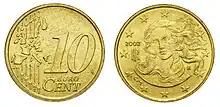
.jpg.webp)
The euro officially began circulating in Italy on 1 January 2002 (even though the creation of Italian lira coins was suspended in 1999).[72] Italian euro coins have a design unique to each denomination, though there are many themes of works by one of the most renowned and famous Italian artists and painters. In particular, on the reverse of Italian euro coins are depicted:[77]
- 1 euro cent coin: Castel del Monte, a 13th-century castle in Andria
- 2 euro cent coin: Mole Antonelliana, a tower symbolising the city of Turin
- 5 euro cent coin: Colosseum, famous Roman amphitheater
- 10 euro cent coin: The Birth of Venus by Sandro Botticelli
- 20 euro cent coin: Futurist sculpture Unique Forms of Continuity in Space by Umberto Boccioni
- 50 euro cent coin: Equestrian Statue of Marcus Aurelius
- 1 euro coin: Vitruvian Man, a drawing by Leonardo da Vinci
- 2 euro coin: Dante Alighieri, an Italian poet, writer and philosopher, considered the father of the Italian language
Each coin is designed by a different designer, from the 1 cent to the 2 euro coin they are: Eugenio Driutti, Luciana De Simoni, Ettore Lorenzo Frapiccini, Claudia Momoni, Maria Angela Cassol, Roberto Mauri, Laura Cretara and Maria Carmela Colaneri. All designs feature the 12 stars of the EU, the year of imprint, the overlapping letters "RI" for Repubblica Italiana (Italian Republic) and the letter R for Rome.[78] There are no Italian euro coins dated earlier than 2002, even though they were certainly minted earlier, as they were first distributed to the public in December 2001.
The choice of the design of the coins was left to the Italian public by means of a television broadcast where alternative designs were presented, letting the people vote by calling a certain telephone number.[79] However, the 1 euro coin was missing in this election, because Carlo Azeglio Ciampi, the then economy minister, had already decided it would sport the Vitruvian man of Leonardo da Vinci.[80] Leonardo's work is highly symbolic as it represents the Renaissance focus on man as the measure of all things, and has simultaneously a round shape that fits the coin perfectly. As Ciampi observed, this represents the "coin to the service of Man", instead of Man to the service of money.
As in Finland and the Netherlands, the minting of 1 and 2 cent coins was suspended in Italy from 1 January 2018. However, coins in circulation have legal value.[81] The cost of creating a one-cent euro coin exceeded its face value. This amounted, in fact, to 4.5 cents. Even for the production of the two cent coin, a sum greater than its value was spent: 5.2 cents.[82]
In 1999, following a technical error, 1,179,335 pieces of 20 cents were minted with the 1999 millage, instead of the 2002 millage foreseen by the issuing decree. The minting error was discovered shortly afterwards and the then director of the Italian mint ordered the immediate deformation of the entire lot; unknown persons nevertheless managed to steal and put into circulation an unspecified number of coins, subject to seizure by the Guardia di Finanza as they were the exclusive property of the State.[83] In 2002 the Italian mint mistakenly minted the reverse side of a hundred 1 cent coins with the Mole Antonelliana (which instead correctly went on the 2 cent coins), instead of the monument of Castel del Monte, in Apulia. Each of these coins has been valued by numismatists at more than 2,500 euros.[84]
See also
References
- "IL FIORINO DI FIRENZE, STORIA DEL "DOLLARO DEL MEDIOEVO"" (in Italian). Retrieved 4 October 2023.
- Nicolò Papadopoli Aldobrandini (2009). Le monete di Venezia descritte ed illustrate da Nicolò Papadopoli Aldobrandini (in Italian). "Progetto Gutenberg Piero Vianelli. p. 136.
- "IL VALORE DELLE MONETE ROMANE" (in Italian). Retrieved 4 October 2023.
- "Italian coins". ilmarengo.com. Archived from the original on 8 August 2017. Retrieved 14 April 2018.
- "Forex Trading Information, Learn About Forex Trading". forex-guide.net. Archived from the original on 26 September 2018. Retrieved 14 April 2018.
- The last country to abandon the Carolingian system was Nigeria in 1973, when the pound was replaced by the naira.
- "Taranto" (in Italian). Retrieved 4 October 2023.
- "L'aes grave di Volterra" (in Italian). Retrieved 4 October 2023.
- Alberto Campana, La monetazione degli insorti italici durante la Guerra sociale (91-87 a.C.), Apparuti Edizioni, 1987, p. 37.
- "Blanchard and Company, Inc. - The Twelve Caesars". Retrieved 8 February 2017.
- Jean Lafaurie et Cécile Morrisson, La pénétration des monnaies byzantines en Gaule mérovingienne et visigotique du VIe au VIIIe siècle, Revue numismatique, 6th series, vol. 29, 1987, p. 40.
- "Moneta, Giunone e Memoria" (in Italian). Retrieved 4 October 2023.
- Buying Power of Roman Coins Archived 10 February 2013 at the Wayback Machine
- See the Ricordanze di S. Maria di Cafaggio, which mentions florins being used in the year MCCL (1250).
- Bernocchi, Mario (1976). Le monete della repubblica fiorentina. Vol. III. Leo S. Olschki Editore. p. 66.
- Bazzicchi, Oreste (2011). Il paradosso francescano tra povertà e società di mercato. Effatà Editrice. p. 98. ISBN 978-88-7402-665-4.
- Hollingsworth, Mary (2017). "A Note to the Reader". The Medici. Head of Zeus. ISBN 978-1-78669-151-4.
- Horner, Susan; Horner, Joanna B. (1884). Walks in Florence and Its Environs. Vol. 2. Smith. p. 125.
- Engel, Pál, 1938-2001. (2001). The realm of St. Stephen : a history of medieval Hungary, 895-1526. London: I.B. Tauris. ISBN 1-4175-4080-X. OCLC 56676014.
{{cite book}}: CS1 maint: multiple names: authors list (link) - Victor Emmanuel III (1915). Corpus Nummorum Italicorum (PDF) (in Italian). Vol. 7. Tipografia dell'Accademia Nazionale dei Lincei. p. 46. Retrieved 23 November 2020..
- Alvise Zorzi (2012). Il denaro di Venezia - Mercati e monete della Serenissima (in Italian). Biblios Edizioni. p. 268. ISBN 978-88-6448-039-8.
- Desimoni, Cornelio. Tavole Descrittive Delle Monete Della Zecca Di Genova Dal 1139-1814 (in Italian). Nabu Press.
- M. Cipolla, Carlo. Economic History of World Population. Trophy Pr; 7 edition.
- Serra, Girolamo. Discorso sulle monete di Genova recitato dal Signor Girolamo Serra rettore dell'Università all'Accademia delle scienze, lettere ed arti, nell'adunanza del dì 15 luglio 1810 (in Italian).
-
 This article incorporates text from a publication now in the public domain: Herbermann, Charles, ed. (1913). "Papal Mint". Catholic Encyclopedia. New York: Robert Appleton Company.
This article incorporates text from a publication now in the public domain: Herbermann, Charles, ed. (1913). "Papal Mint". Catholic Encyclopedia. New York: Robert Appleton Company. - Marco Dubbini e Giancarlo Mancinelli Storia delle monete di Ancona, edizioni Il lavoro editoriale, Ancona 2009, ISBN 978-88-7663-451-2
- Massimo Sozzi, L'Agontano di Massa di Maremma, in "L'Agontano. Una moneta d'argento per l'Italia medievale", edited by Lucia Travaini, Atti del Convegno di Trevi, 11-12 ottobre 2001, Perugia, Centro Stampa della Regione Umbria, 2003, pp. 111-140.
- Voce sull'agontano nell'Enciclopedia Treccani
- Voce Agontano sull'enciclopedia Sapere.it
- David Murray Fox; Wolfgang Ernst (2016). Money in the Western Legal Tradition: Middle Ages to Bretton Woods. Oxford University Press. p. 257. ISBN 978-0-19-870474-4.
- Soldo. merriam-webster.com
- Christopher Kleinhenz (2 August 2004). Medieval Italy: An Encyclopedia. Routledge. p. 267. ISBN 978-1-135-94880-1.
- European and Islamic trade in the early Ottoman state by Kate Fleet p.15
- Catalogue of the Byzantine Coins by Dumbarton Oaks, Alfred Raymond Bellinger, Philip Grierson, Whittemore Collection (Fogg Art Museum) p.33
- Philip Grierson; Lucia Travaini (1998). Medieval European Coinage: Volume 14, South Italy, Sicily, Sardinia. Cambridge University Press. p. 220. ISBN 978-0521582315.
- "Monete di Bologna" (in Italian). Retrieved 6 October 2023.
- Grierson, Philip; Travaini, Lucia (1998). Medieval European Coinage. Volume 14: Italy III: South Italy, Sicily, Sardinia. Cambridge University Press. p. 455. ISBN 978-0-521-58231-5.
- Abulafia, David (1992). Frederick II: A Medieval Emperor (Oxford Paperbacks ed.). Oxford University Press. p. 222. ISBN 978-0-19-508040-7.
The augustalis continued to be struck in the regno throughout the rest of the reign, and was even continued by later kings.
- Grierson, Philip; Travaini, Lucia (1998). Medieval European Coinage. Volume 14: Italy III: South Italy, Sicily, Sardinia. Cambridge University Press. p. 187. ISBN 978-0-521-58231-5.
Sambon and others have supposed that augustales in Frederick's name continued to be issued [by his successors] down to 1266, which is possible but unsupported by positive evidence.
- Grierson, Philip; Travaini, Lucia (1998). Medieval European Coinage. Volume 14: Italy III: South Italy, Sicily, Sardinia. Cambridge University Press. p. 172. ISBN 978-0-521-58231-5.
- Augustale at the Encyclopædia Britannica (2008). Retrieved 7 October 2008.
- Edoardo Martinori (1915). La moneta: vocabolario generale (in Italian). Istituto italiano di numismatica. Retrieved 20 March 2023.
- Pinchera, S (a cura di) (1957). Monete e zecche nello stato pontificio dalla restaurazione al 1870 [Coins and mints in the papal state from the restoration to 1870]. Archivio economico dell’unificazione italiana. Vol. V, fasc. 3. Roma.
{{cite book}}: CS1 maint: location missing publisher (link) (cited in Rossi, Marinella (2013). La borsa di Roma dal 1847 al 1860 [The Rome Stock Exchange from 1847 to 1860] (PDF) (Thesis) (in Italian). Tesionline. p. 1. Archived (PDF) from the original on 27 September 2007. Retrieved 4 February 2010. (first degree thesis)) - Eleni Sakellariou, Southern Italy in the Late Middle Ages: Demographic, Institutional and Economic Change in the Kingdom of Naples, c.1440–c.1530 (Brill, 2012), p. 492.
- Stephan R. Epstein, An Island for Itself: Economic Development and Social Change in Late Medieval Sicily (Cambridge University Press, 1992), p. xii.
- "Cronologia" (in Italian). Retrieved 6 October 2023.
- Krause, Chester L.; Clifford Mishler (1978). Standard Catalog of World Coins: 1979 Edition. Colin R. Bruce II (senior editor) (5th ed.). Krause Publications. ISBN 0873410203.
- Krause, Chester L.; Clifford Mishler (1991). Standard Catalog of World Coins: 1801–1991 (18th ed.). Krause Publications. ISBN 0873411501.
- "VALORE CORRENTE DELLE MONETE DEL REGNO DELLE DUE SICILIE" (in Italian). Retrieved 6 October 2023.
- A Handbook for Travellers in Southern Italy (1868)
- A Handbook for Travellers in Southern Italy (1868)
- "MONETE CIRCOLANTI LIRA SARDA E ITALIANA DA METÁ 1800 SINO AL 1900 E NOMI IN MAMOIADINO" (PDF) (in Italian). Retrieved 6 October 2023.
- This fact was quite obvious, because the pound was equivalent to 240 denari or 60 quattrini, while the Tuscan florin was equivalent to 100 quattrini or 400 denari.
- Rivista italiana di Numismatica (PDF) (in Italian). Vol. 6. Società Numismatica Italiana. 1958. p. 87.
- Guida d'Italia, Albania. Touring Editore. 1940. pp. 13–14. Retrieved 11 May 2019.
- "Banca d'Italia Annual Report for 1982 - page 187" (PDF). bancaditalia.it. 31 May 1983. Retrieved 20 June 2022.
- "A miniassegni issued by the Banca Popolare di Milano using "LIT." as the currency sign". 20 June 2019. Archived from the original on 6 December 2022. Retrieved 20 June 2022.
- "A cheque issued by the Cassa Rurale ed Artigiana di Gaudiano di Lavello using a script version of "Lit."". 30 August 2015. Archived from the original on 6 December 2022. Retrieved 20 June 2022.
- "Italy". CIA World Factbook 1990 - page 178. 1 April 1990. Retrieved 21 June 2022.
- "1933 Registration Form of the Reale Automobile Club d'Italia prominently displaying "£50'000" in handwriting". Archived from the original on 6 December 2022. Retrieved 20 June 2022.
- "An old price display sign in use in Sicily marked with both the lira and euro signs". Archived from the original on 6 December 2022. Retrieved 20 June 2022.
- "Category:Coins of the Kingdom of Italy by year".
- "Category:Coins of the Italian Republic by year".
- Alfredo Taracchini (1999). Addio, cara Lira (in Italian). Edizioni Pendragon. p. 79. ISBN 978-8883420146.
- Alfredo Taracchini (1999). Addio, cara Lira (in Italian). Edizioni Pendragon. p. 80. ISBN 978-8883420146.
- "REGIO DECRETO 17 luglio 1861, n. 123" (in Italian). Retrieved 7 October 2023.
- "LEGGE 24 agosto 1862, n. 788" (in Italian). Retrieved 7 October 2023.
- "Poesie e Prose in dialetto". dialettando.com. Archived from the original on 2 July 2019. Retrieved 14 April 2018.
- Storia del CNI
- La collezione numismatica di Vittorio Emanuele III di Savoia
- Peter Neville. 2003. Mussolini. Routledge. ISBN 0-415-24989-9. p. 77.
- "Italian Republic coins". ilmarengo.com. Archived from the original on 2 May 2015. Retrieved 14 April 2018.
- "Fondo Monetario Internazionale – Ministero degli Affari Esteri e della Cooperazione Internazionale" (in Italian). Retrieved 4 January 2022.
- Alfredo Taracchini (1999). Addio, cara Lira (in Italian). Edizioni Pendragon. p. 182. ISBN 978-8883420146.
- Alfredo Taracchini (1999). Addio, cara Lira (in Italian). Edizioni Pendragon. p. 183. ISBN 978-8883420146.
- "Ultimalira: Storia della Lira". Archived from the original on 15 May 2007. Retrieved 4 February 2010.
- "Cos'è raffigurato sulle monete italiane?" (in Italian). Retrieved 6 October 2023.
- "Buy the Italian euro coins". Archived from the original on 10 January 2010. Retrieved 4 February 2010.
- Archivio RAI Archived 2011-11-17 at the Wayback Machine
- "Scoppia la febbre dell'Euro". 9 February 1998. Retrieved 11 October 2013.
- "Addio monete da 1 e 2 centesimi, sospeso il conio. Cosa cambia" (in Italian). Retrieved 6 September 2022.
- "La Camera vota: addio alle monetine". Archived from the original on 8 May 2014. Retrieved 7 May 2014.
- "20 centesimi di Euro" (in Italian). Retrieved 6 September 2022.
- "Ecco la moneta da 1 centesimo che vale 2500 euro" (in Italian). Retrieved 6 September 2022.
